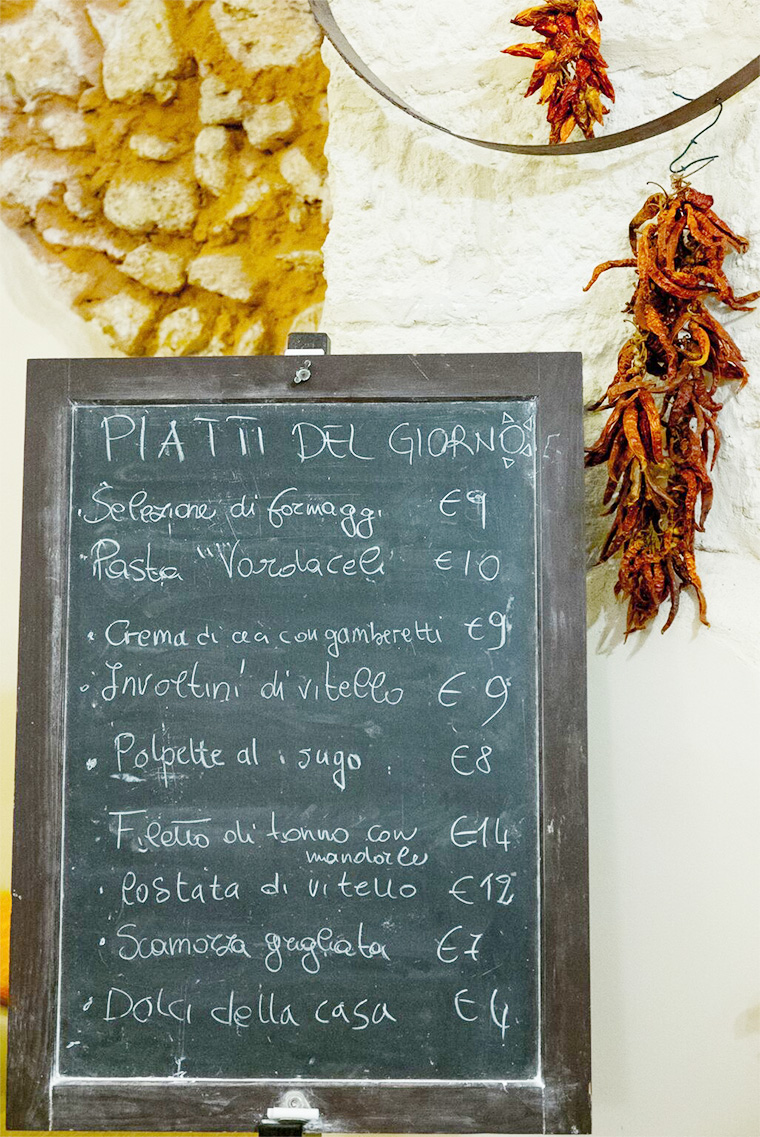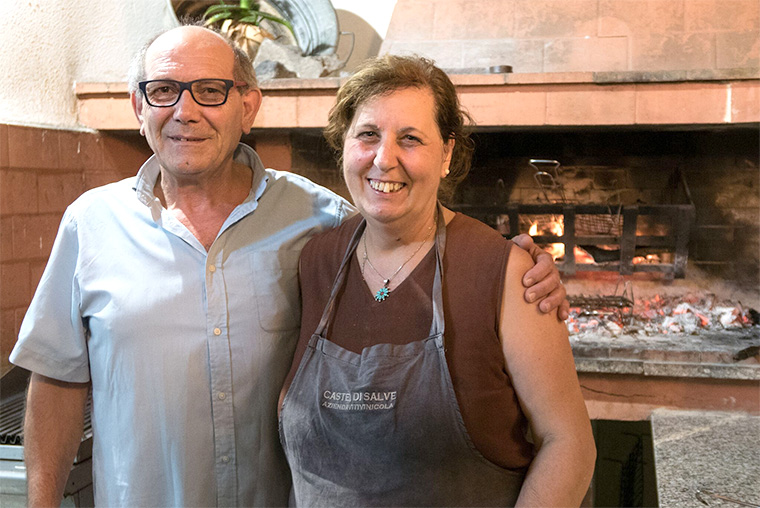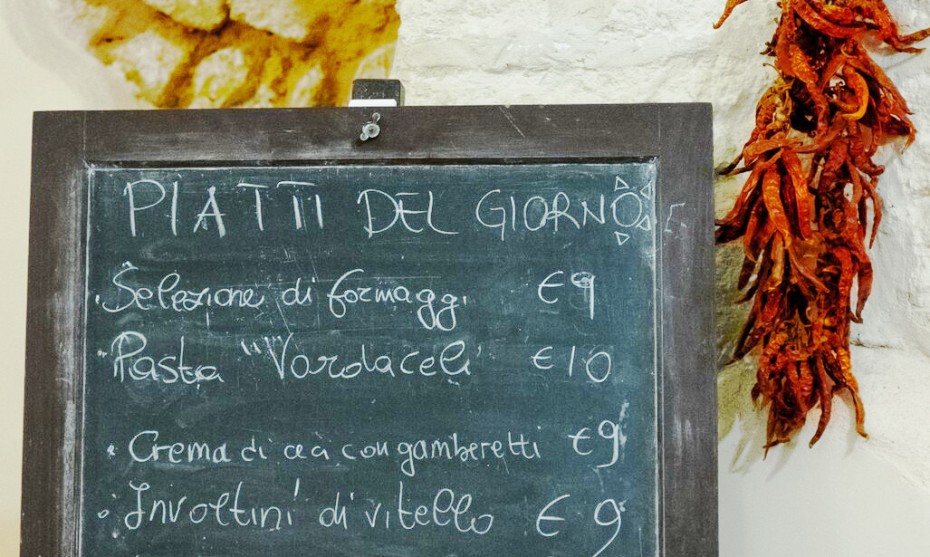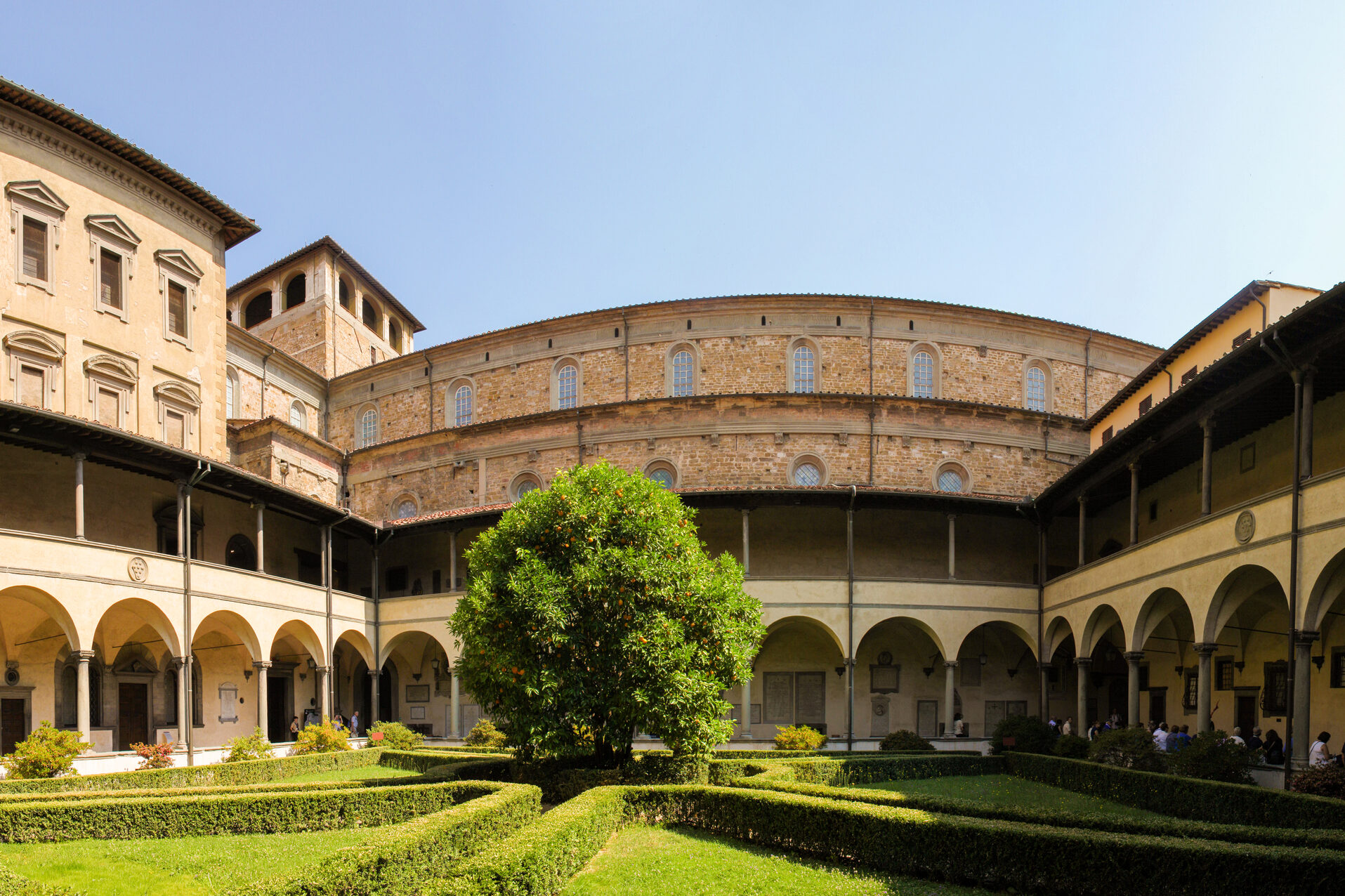It is a hot summer night in Montesano, a little town we go to in the Salento, Puglia’s southern peninsula, and the nearest trattoria is booked. Our friend and host who owns a house here suggests trying another place off the beaten track in Castiglione d’Otranto, an ancient Greek town next to ours. Trattoria Vardaceli, named after the small but potent fiery red pepper the region loves, has a table for us. Salvatore Mastria and his wife, Rocchetta De Filippis own the restaurant and Rocchetta does all the cooking. Salvatore runs the dining room and he brings us a basket of hot pittule, savory little fritters cooked in olive oil that you find throughout Puglia. These are flavored with bits of green onion, and seductive tidbits they are.
Scanning the slateboard menu, my eyes fall on the crema di ceci coi gamberetti e pasta fritta, chick-pea cream with little shrimps and crunchy fried noodles. The description “grabs my throat,” to use an Italian expression for the sensation one feels at such a moment of anticipated culinary delight. (Why don’t we have such a gripping food metaphor in English, I’ve often wondered?) The “pasta fritta” conjures up ciceri e tria, another local specialty of combined soft and crispy semolina noodles tossed with an oniony chick-pea puree that I ate on my very first visit to the Salento long ago. The crema di ceci, an unexpected combination of flavors, sounds even better to me on this sweltering evening. Having been reared on the notion that such temperatures demand steamy, not cool, food to adjust oneself to the heat, it feels just the dish for supper.

We place our order and after some time (and a good thing the pittule are there to tame our hunger), Salvatore returns with my soup: a smooth puree of chick-peas with pink shrimps bobbing in it, a filo, “thread” of deep green olive oil lacing the surface, and a heap of crunchy noodles atop. It is delicious and well worth waiting for, so much so that the thought of it lingers long after we leave.
A week later, I go back to Trattoria Vardaceli for to have the soup again and this time, congratulate the chef by way of Salvatore. This prompts an invitation to meet her and after our dinner, we are led to a blazing wall-to-wall, wood-fired barbecue pit loaded with lamb chops and stuffed meat rolls sputtering on the flames. The fire is flanked by the kitchen on one side; the garden where our table is on the other. Rocchetta ducks out from behind her stove to greet us, pleased for the compliment, and stations herself where she can keep an eye on the goings on in the kitchen while we chat.
“No one makes this dish at home anymore,” she says. “People know they can come here find the kind of food our ancestors made.”
“Signora, I am sorry to disturb you,” I offer, feeling it couldn’t be a good moment to be making a kitchen visit. But she continues.

“It is never a bad moment because I am always here cooking this food that I love. It is simple food, but is good food,” she says.
We are all shining with sweat and smiles, even while, I imagine, she has been working in the kitchen since early morning. She rattles off the soup recipe before planting kisses on my cheeks, and leaps back into the kitchen adjoining the wall of fire, which must be an inferno tonight.
Here is Rocchetta’s recipe, adapted for the American kitchen, which I later recreated at home based on my notes of the evening. I feel that I should have done more to earn it in light of her labors, but it was offered cheerfully and willingly. The soup is fine eating for cool weather as well.
Puréed Chick-Pea Soup with Shrimp and Crispy Noodles in the Style of the Salento
Crema di ceci coi gamberi e tria fritta alla salentina
For 4 people
Plan two days ahead as you will need this much time to soak the dried chick-peas. The flavor of dried and rehydrated chick-peas is superior to the canned alternative, and their tasty cooking water is necessary for the soup. There is no garlic here— garlic is not in widespread use in the Salento and when I asked Salvatore about it, he said that Rocchetta used onion alone. This is consistent with the custom in the southern part of Puglia (the reverse is true in the northern provinces of the region where garlic is more prevalent). As for vardaceli, hot pepper, it was curiously missing in Rocchetta’s oral recipe. In light of the trattoria’s name, I added a pinch. The “trie,” the traditional pasta of the region that tops the soup should be made fresh using semolina flour and water alone (no egg). Inevitably, readers will ask if they might substitute other kinds of fried noodles or crumbled bacon, or fried croutons or what have you. Of course, one might do anything, but then, it would no longer be Rocchetta’s recipe.
To soak and cook the chick-peas:
• 3/4 pound dried chick-peas
• cool water
For the soup:
• 6 tablespoons extra-virgin olive oil, plus additional for finishing
• 16 small or medium shrimps, peeled and deveined
• 1 onion, chopped
• 1 celery stalk with leaves, chopped
• 1/8 teaspoon of ground cinnamon
• pinch, or to taste, hot chili flakes
• 2 tablespoons chopped fresh flat-leaf parsley
For the noodles:
• about 1 cup semolina (Italian semola) flour, plus additional as needed
• extra-virgin olive oil for frying
• fine sea salt
1 Pick over the chick-peas to remove any stones and agitate them to shake out any impurities. Transfer them to a sieve and rinse them well in cool running water. Place them in a bowl with cool water to cover by three inches; cover and chill overnight. Drain and rinse them and return them to the bowl with fresh cold water. Soak, chilled, for another 24 hours.
2 Drain and rinse the chick-peas well. Transfer them to an ample pot with four inches of cold water to cover. Bring to a boil, reduce to a simmer, and cook until the chick-peas are soft, 1-1/2 hours or longer, partially covered, skimming off any foam or loosened skins that float to the water surface. If they starts to dry out, add more water as needed to keep the water level about 2 inches above the chick-peas as they cook. Turn off the heat and set aside.
3 While the chick-peas are cooking, make the pasta. Sprinkle a work surface lighlty with semolina flour. Put the 1 cup of flour into a mixing bowl. In a measuring cup, blend 1/2 teaspoon sea salt in 1/3 cup very warm water and add it to the flour a little at a time, stirring with a fork initially, then using your hands to form a ball of dough. Add a little more water or flour as necessary for a firm but tender consistency. Turn the dough ball out on to the work surface and continue to knead it until it is smooth and pliable. Cover the dough with an inverted bowl to relax the protein in the flour, 30 minutes. Use a rolling pin or hand-cranked roller-type pasta machine to roll it out to a thicknesss of about 1/32-inch. This is easier done using the machine, passing the dough through each notch until you get to the next-to-last. Cut the rolled-out dough into noodles about 1/-8-inch wide. Set the pasta aside until you are ready to fry it.
4 Getting back to the chick-peas, use a strainer or skimmer to lift out them out of the water. Transfer them to a bowl and reserve the cooking water. If you would like a velvety texture, it is best to slip off and discard their skins. If you find this step is too tedious, you will need a food mill or strainer when it is time to puree the soup.
5 Rinse the shrimp in cold water and blot dry with paper towel.
6 In a Dutch oven or ample skillet, warm the 6 tablespoons olive oil over gentle heat. Increase the heat to medium and add the shrimp; sauté until they are pink on both sides, about 5 minutes in total. Transfer them to a side dish and set aside. To the pan, add the onion and celery and saute the vegetables over medium-low heat without browning until they are well softened, about 12 minutes. Stir in the cinnamon and chili flakes, and saute gently for a minute more. Add the cooked chick-peas and enough of their cooking water to cover by about 2 inches. Simmer gently, covered, with the lid slightly askew to marry flavors, about 10 minutes. Turn off the heat.
7 When the chick-peas have cooled somewhat, pass the mixture through a sieve or a food mill with a little of the reserved cooking water to form a smooth puree. If you have taken the time to remove the skins from the chick-peas previously, you can puree them using an immersion blender or in a food processor instead. Return the puree to the pan in which it has cooked, adding some of the reserved chick-pea cooking water as necessary for a creamy consistency.
8 Just before you are ready to serve, warm the safflower or vegetable oil in an ample skillet. Fry the noodles until they are crisp. Drain them on paper towel.
9 Warm the purée and season it with salt.
10 Ladle the soup into individual serving bowls. Float the reserved shrimp on each portion, followed by a dribble of extra-virgin olive oil from the bottle, a sprinkle of parsley, and a decoration of crispy noodles. Serve at once.
Julia della Croce is a food writer and James Beard award-winning cookbook author and recipe developer based in New York. She is presently incubating a book about her family’s ancestral region, Sardegna. Visit her website, www.juliadellacroce.com and blog, http://juliadellacroce.com/forktales1/, connect on Facebook: Julia della Croce – chef & foodwriter, Twitter: @juliadellacroce and Instagram: juliadellacroce.






























